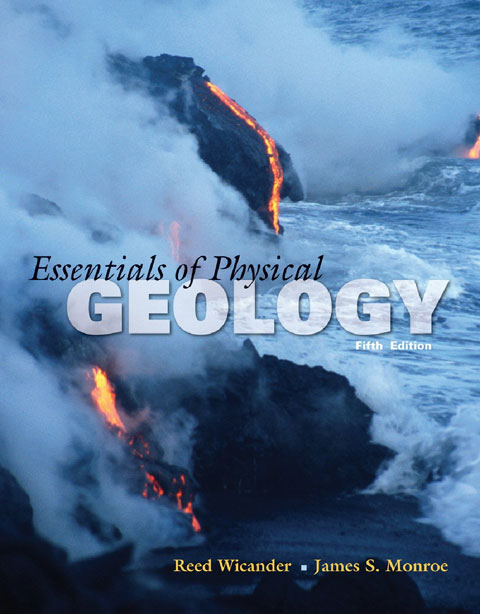
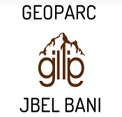
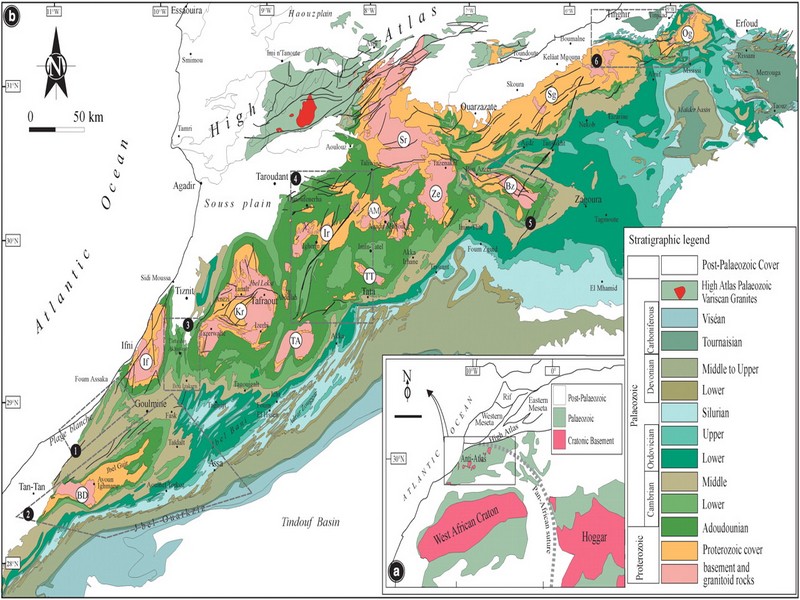
A short overview of the Anti-Atlas, Morocco
DR.Hervé Rezeau, DR.Cyril Chelle-Michou & DR.Michael Calder
SEG Student Chapter of Geneva (Switzerland)
SEG Student Chapter of Montpellier (France)
INTRODUCTION
Geology of Morocco has been subdivided into four structural domains, from north to south they are the following: the Rif domain, the Meseta domain, the High Atlas, and the Anti-Atlas, as they are shown in (Figure 1).
The Rif Range extends along the Mediterranean coast from the Kabylian-Tellian belts up to the Strait of Gibraltar. South of it, the Meseta domain is located, where elevated plateaus and intramontane basins occur. Further south the High Atlas system is found, which displays several massifs close to 4000 m, including the highest peak of northern Africa (Jebel Toubkal). The Middle Atlas represents a branch of the Atlas system that extends obliquely across the Meseta domain, and exceeds 3000 m in elevation. Finally, the Anti-Atlas domain is found, which rises forming a massive mountain that achieves up to 2700 m. Further south the elevation decreases both southward and westward from ca. 1000 m to less than 200 m close to the Atlantic.
Figure 1: Elevation map of Morocco and neighbouring countries from GTOPO30 database (A. Michard et al. 2008)
GEOLOGICAL SETTING OF THE ANTI-ATLAS
The Anti-Atlas mountain belt is located in the northern part of the West African Craton (WAC). It is stretching NE-SW and is characterized by Precambrian to late Proterozoic rocks covered by younger sediments of Edicaran to Cambrian in age. The geological boundary between the Anti-Atlas and High Atlas is structurally marked by the South Atlas fault (SAF) (Fig.2). The Anti-Atlas massif is a zone of wide domal uplift with much weaker Alpine age deformation. The volcanics and conglomerates rocks from the Ouarzazate & Bou Salda group in the North-East are surrounding the older volcanics rocks
The Anti-Atlas mountain belt is located in the northern part of the West African Craton (WAC). It is stretching NE-SW and is characterized by Precambrian to late Proterozoic rocks covered by younger sediments of Edicaran to Cambrian in age. The geological boundary between the Anti-Atlas and High Atlas is structurally marked by the South Atlas fault (SAF) (Fig.2). The Anti-Atlas massif is a zone of wide domal uplift with much weaker Alpine age deformation. The volcanics and conglomerates rocks from the Ouarzazate & Bou Salda group in the North-East are surrounding the older volcanics rocks and turbidite sequences from the Sahgro Group and the Pan-African granite intrusions. This geomorphological feature is commonly called inliers (“boutonnière” in French) and is the result of an exposed older rock formation surrounded by younger rock, and is due to a high erosion rate of rocks with different hardness but also encouraged by deformation such as folding and faulting (Gasquet et al. 2005). Several slivers of ophiolites are present in the Anti-Atlas belt, the best preserved are situated in the Bou Azzer, Siroua and Iriri region, which represent remnant of an ocean closure. The basement is composed of schists, granites and mylonites of Paleoproterozoic age. The latest Variscan and Alpine orogenic events overprint most of the Anti-Atlas geological province and thus complicate the Pre- Cambrian geodynamic interpretation. However, two main periods of tectono-thermal magmatic activity (Gasquet et al. 2005) are now recognised :
(i)A Palaeoproterozoic period, corresponding to the Eburnean (Birimian) orogeny,
(ii)A Neoproterozoic period, corresponding to the Pan-African orogeny.
Figure 2: Schematic map of the Anti-Atlas Precambrian inliers (Boutonnière), and location of the maps, satellite views and lithospheric profile presented hereafter (Gasquet et al. 2008)
Source web : DR.Hervé Rezeau, DR.Cyril Chelle-Michou & DR.Michael Calder unige.ch
Les articles en relation

Bouafen et Oued Tamzarar
L'oued Tamzarar Sur la piste d’Akka à la route d’Icht, dans l’oued Tamzarar, sur la falaises rive gauche, la majorité des gravures est située sur des parois verticales à partir d&rsqu
Savoir plus...
Recherches archéologiques sur les origines de la ville de Rirha /Gilda
Recherches archéologiques sur les origines de la ville de Rirha /Gilda 1. Intérêt scientifique : Le programme de recherches sur Rirha men&
Savoir plus...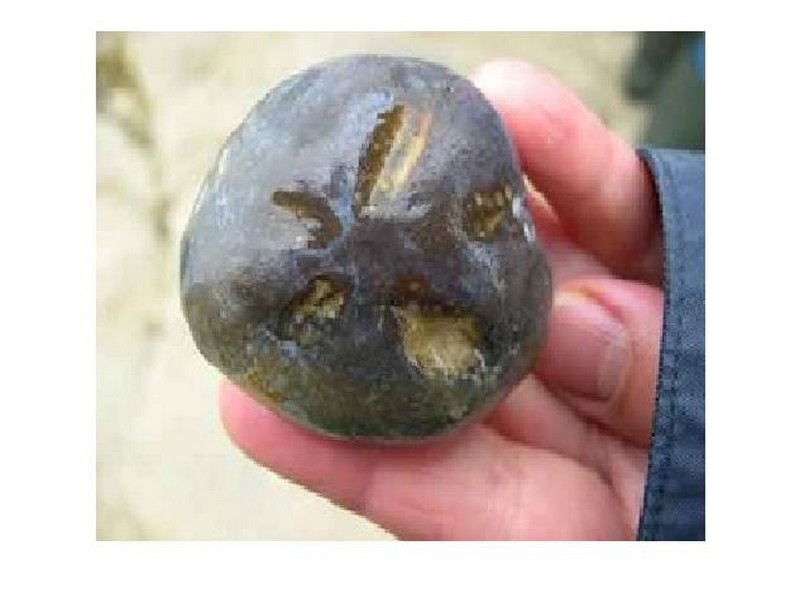
Bourse aux minéraux et fossiles
Bourse aux minéraux et fossiles A découvrir, une bourse minéraux et fossiles sur Internet, pour échanger, vendre, acheter des minéraux, fossiles, roches, livres sur la géologie, micromounts,
Savoir plus...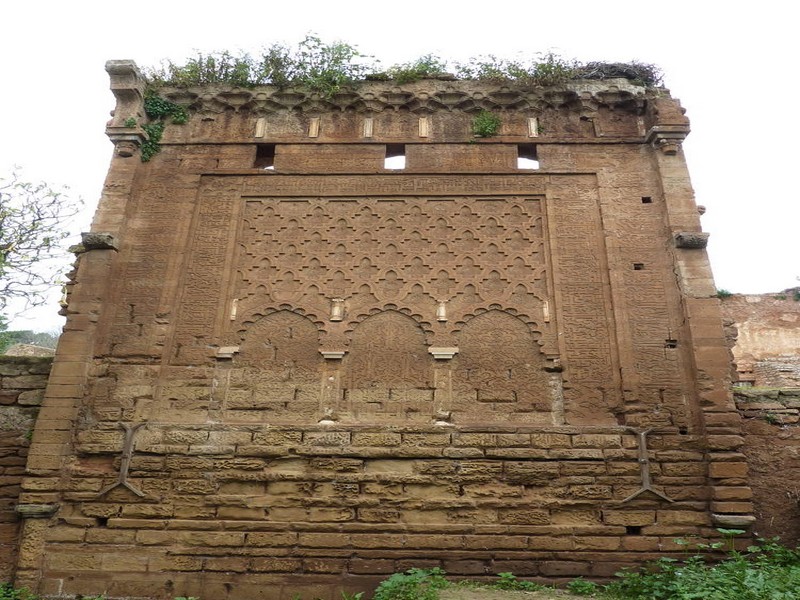
Médina d’Essaouira (ancienne Mog Rabat, capitale moderne et ville historique : un patrimoine en partage
Médina d’Essaouira (ancienne Mog Rabat, capitale moderne et ville historique : un patrimoine en partage Située sur la façade atlantique, au nord-ouest du Maroc, Rabat est le résultat d’un dialo
Savoir plus...
Un exemple d’analyse-étude, de requalification et sauvegarde du patrimoine culturel et architectural de l’oasis de Figuig
Un exemple d’analyse-étude, de requalification et sauvegarde du patrimoine culturel et architectural de l’oasis de Figuig Monsieur Maurizio CAFAREllI, Directeur du programme Restauration du patrimoine de l’Or
Savoir plus...
Honor View 20, un smartphone avec un trou dans l'écran
Honor View 20, un smartphone avec un trou dans l'écran Trois innovations dans le nouveau smartphone haut de gamme Honor : un capteur caché directement dans l’écran, un capteur de 48 millions de pixels e
Savoir plus...
Circuit 5 jours de Guelmim vers Agadir-géoparc jbel bani
Circuit 5 jours de Guelmim vers Agadir-géoparc jbel bani Çircuit de 5 jours : Circuito en 5 dias - Circuit in 5 days Jour 1 - Guelmim - Amtoudi - Akka - Tata Jour 2 - Tissint - Akka Naït Sidi Jour
Savoir plus...
Assa-Zag: Le village écologique Labouirat labellisé COP22
Assa-Zag: Le village écologique Labouirat labellisé COP22 Le projet du village écologique Labouirate qui sera construit dans la province d’Assa-Zag (région Guelmim-Oued Noun) vient d’être
Savoir plus...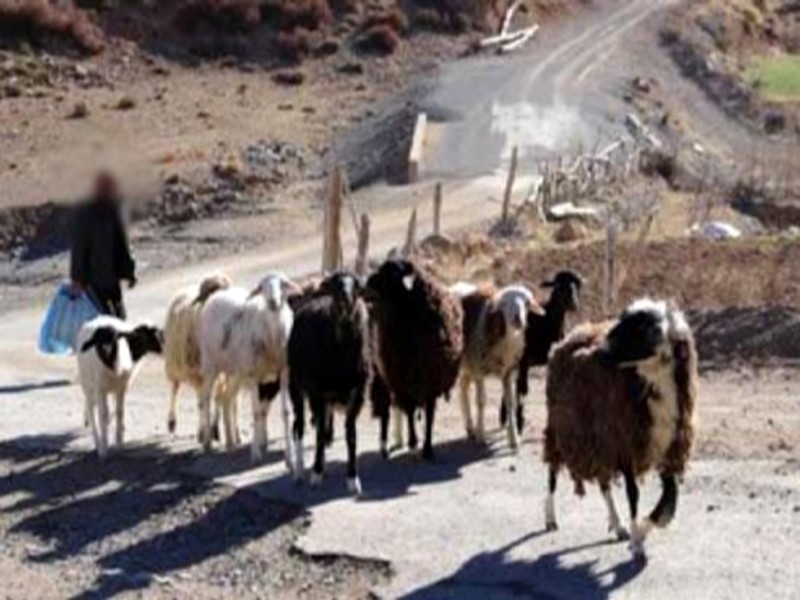
Nomad #26 : Igîlîz, la perle archéologique de Taroudant
Le prix d’archéologie de la fondation Simone et Cino Del Duca a été décerné en 2015, à une mission archéologique franco-marocaine. Cette dernière a mis en lumière un s
Savoir plus...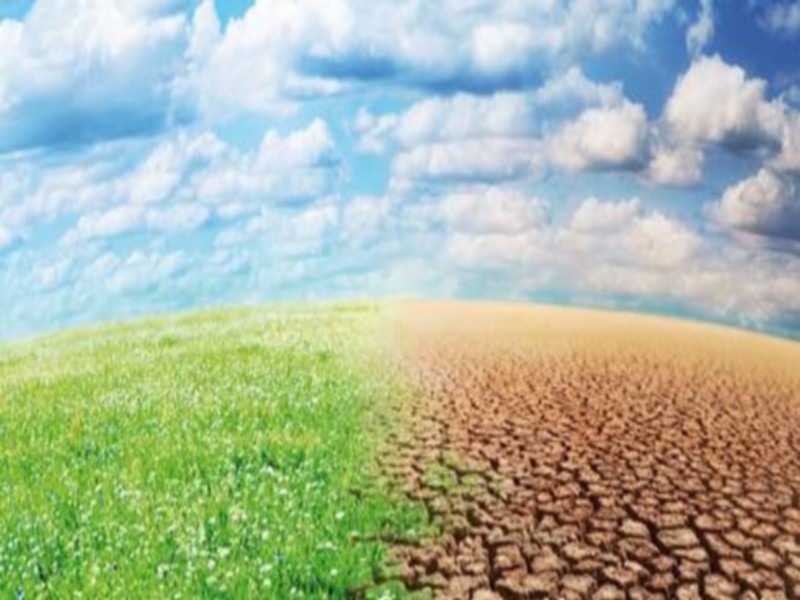
Prise de décision relative au changement climatique: Quel rôle joue vraiment la météo ?
Prise de décision relative au changement climatique: Quel rôle joue vraiment la météo ? La prise de décision relative au changement climatique est fortement liée aux données mét&
Savoir plus...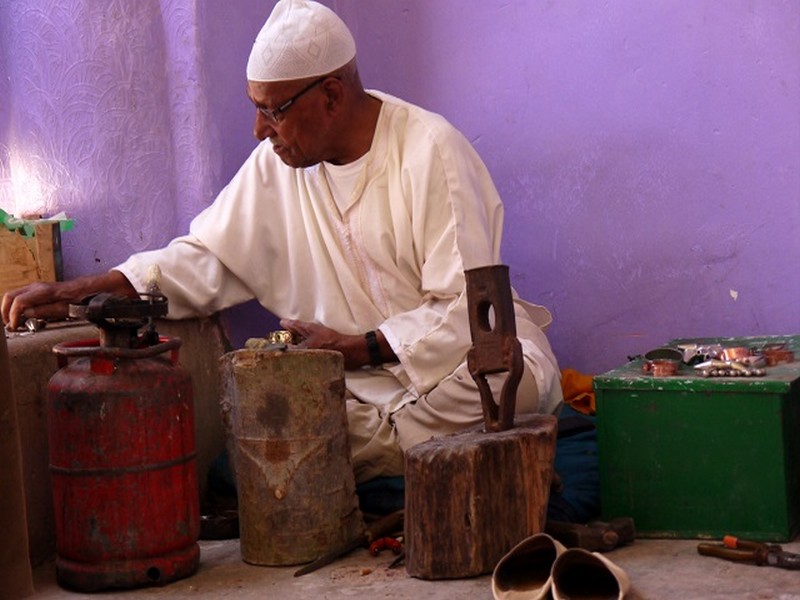
Artisanat : Les artisans marocains
Indifférents au temps qui passe, les artisans du sud Maroc ont de tout temps joué un rôle prépondérant dans le quotidien des populations berbères. Au départ essentiellement domestique,
Savoir plus...Les tags en relation
En savoir plus sur " Géologie et TSGJB - AMDGJB "
Consulter les vidéos de " Géologie et TSGJB - AMDGJB " Consulter les photos de " Géologie et TSGJB - AMDGJB " Consulter les publications de " Géologie et TSGJB - AMDGJB " Consulter les éditions de " Géologie et TSGJB - AMDGJB " Consulter les communications de " Géologie et TSGJB - AMDGJB "Recherche du site
Recherche avancée / Spécifique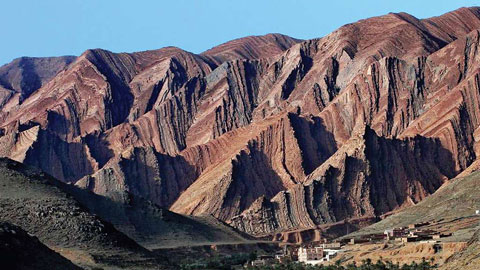
Géoparc et Recherche Scientifique
Le coins de l’étudiant
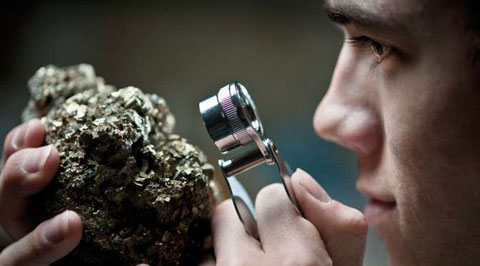


Blog Géoparc Jbel Bani
Dictionnaire scientifique
Plus de 123.000 mots scientifiques
Les publications
Géo parc Jbel Bani
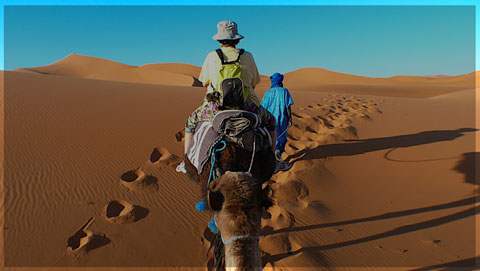
Circuits & excursions touristiques
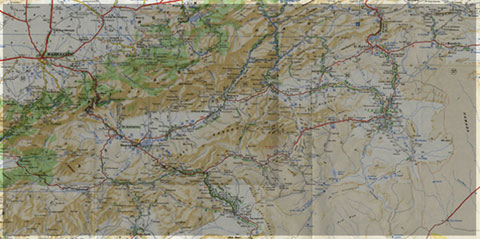
cartothéques
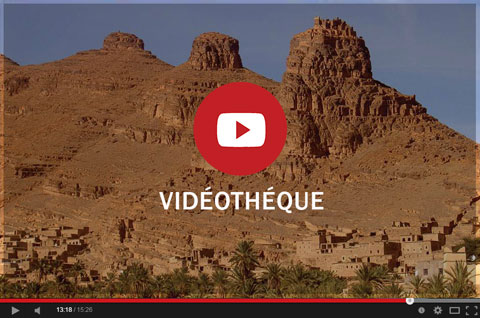
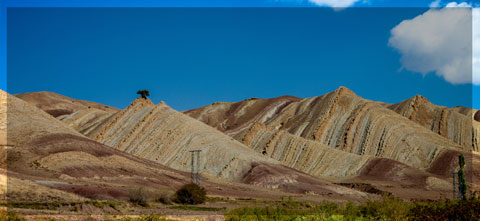
Photothéques
Publications & éditions
